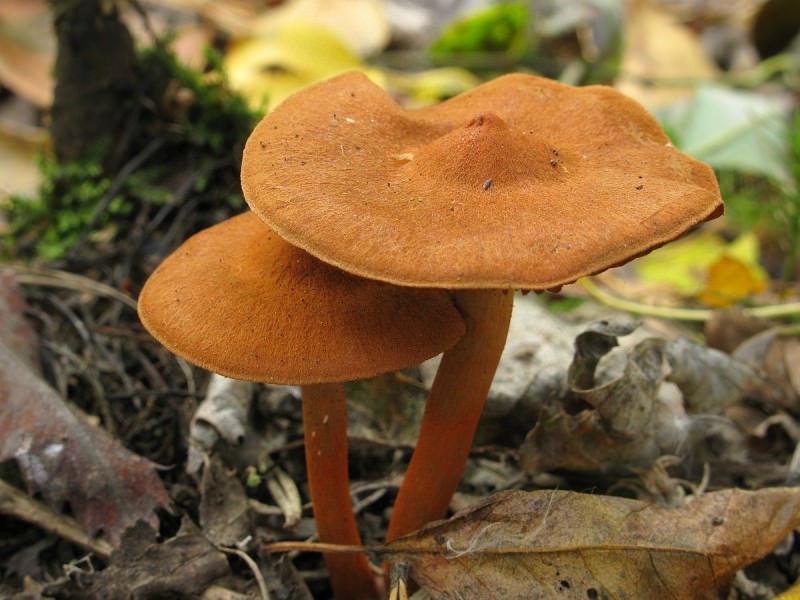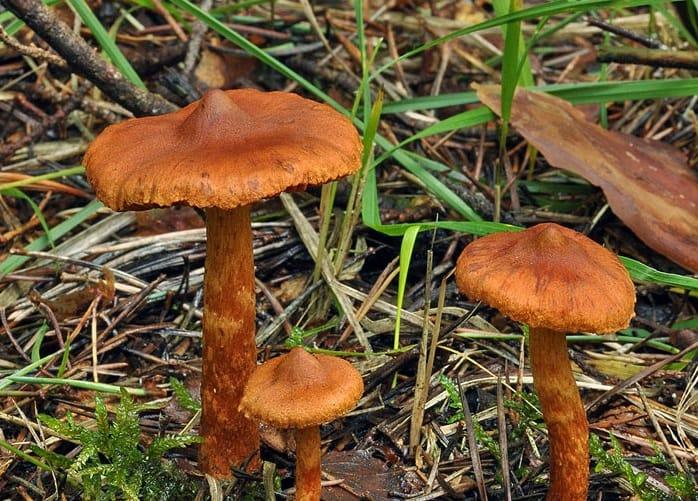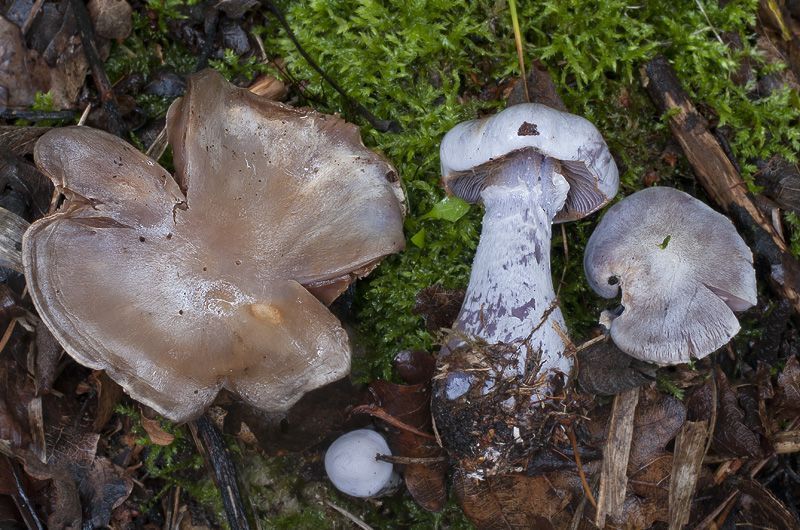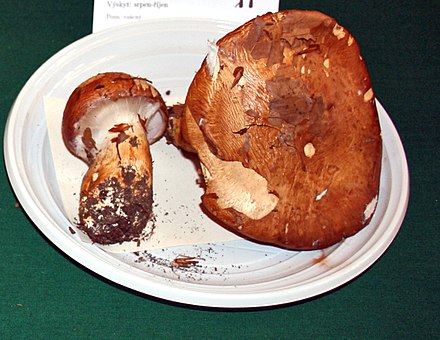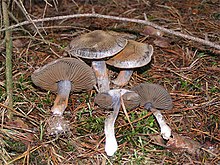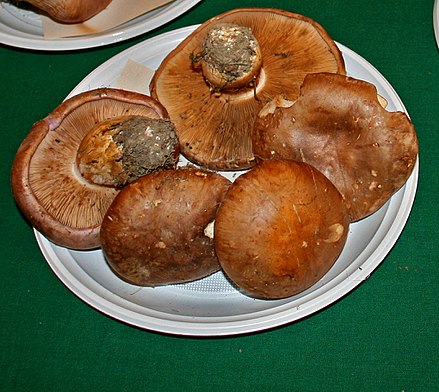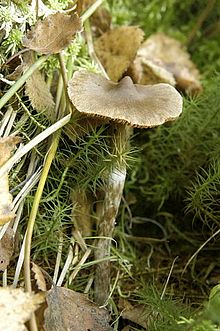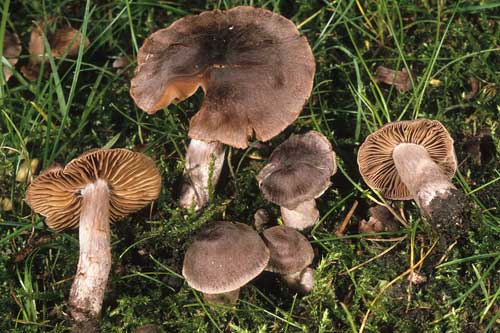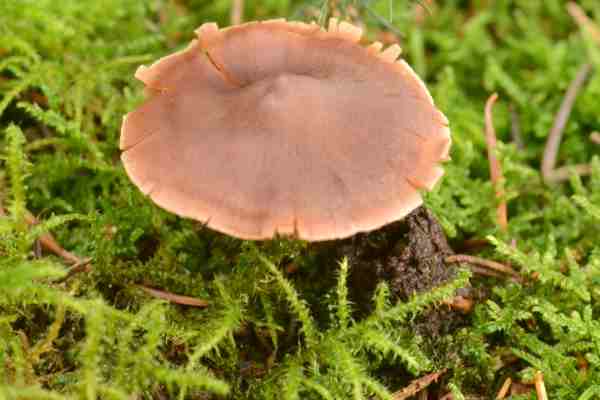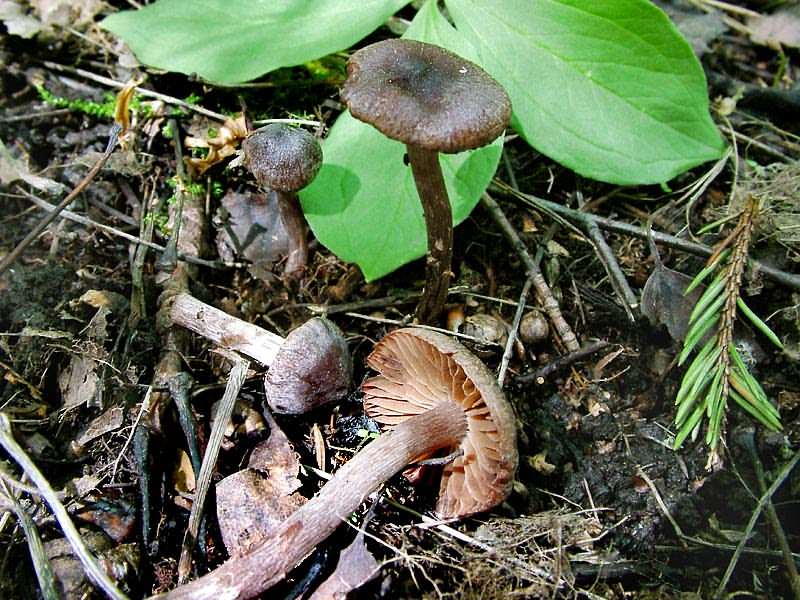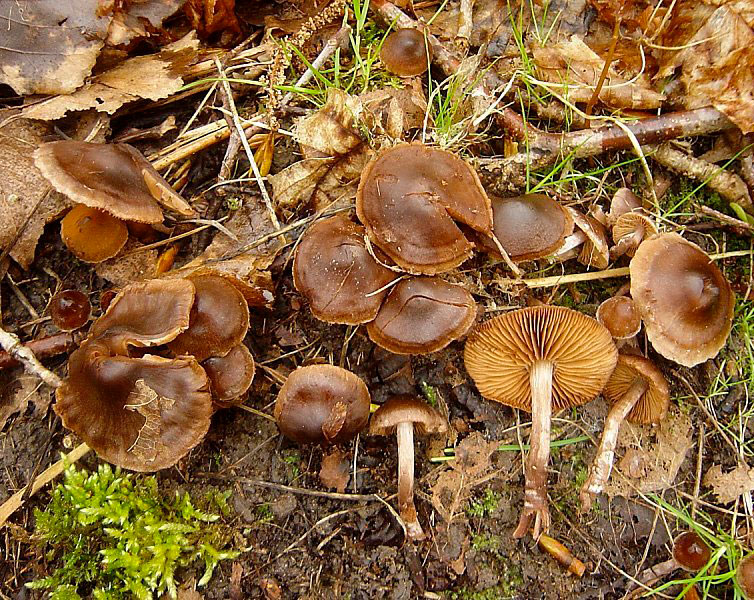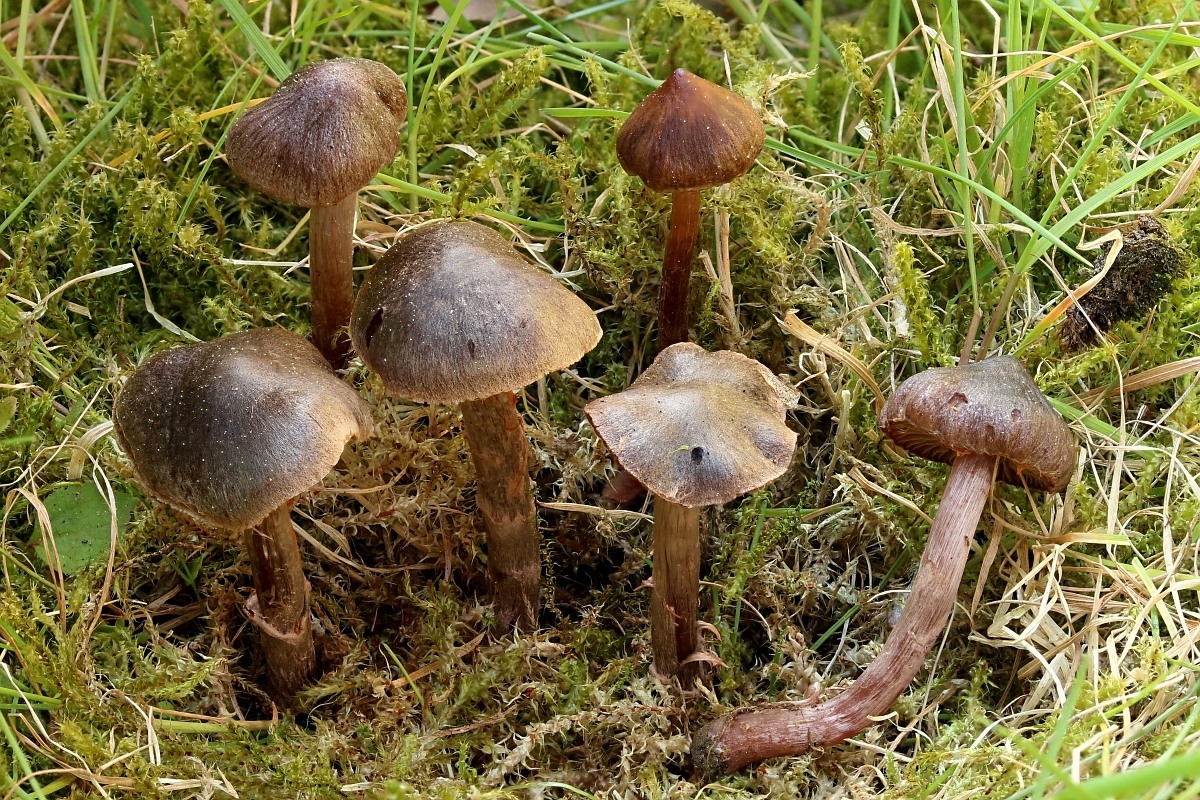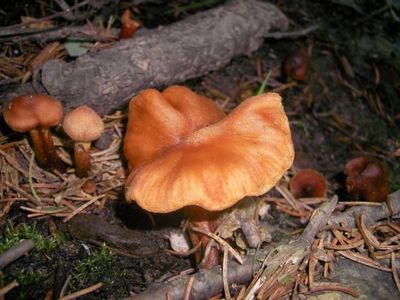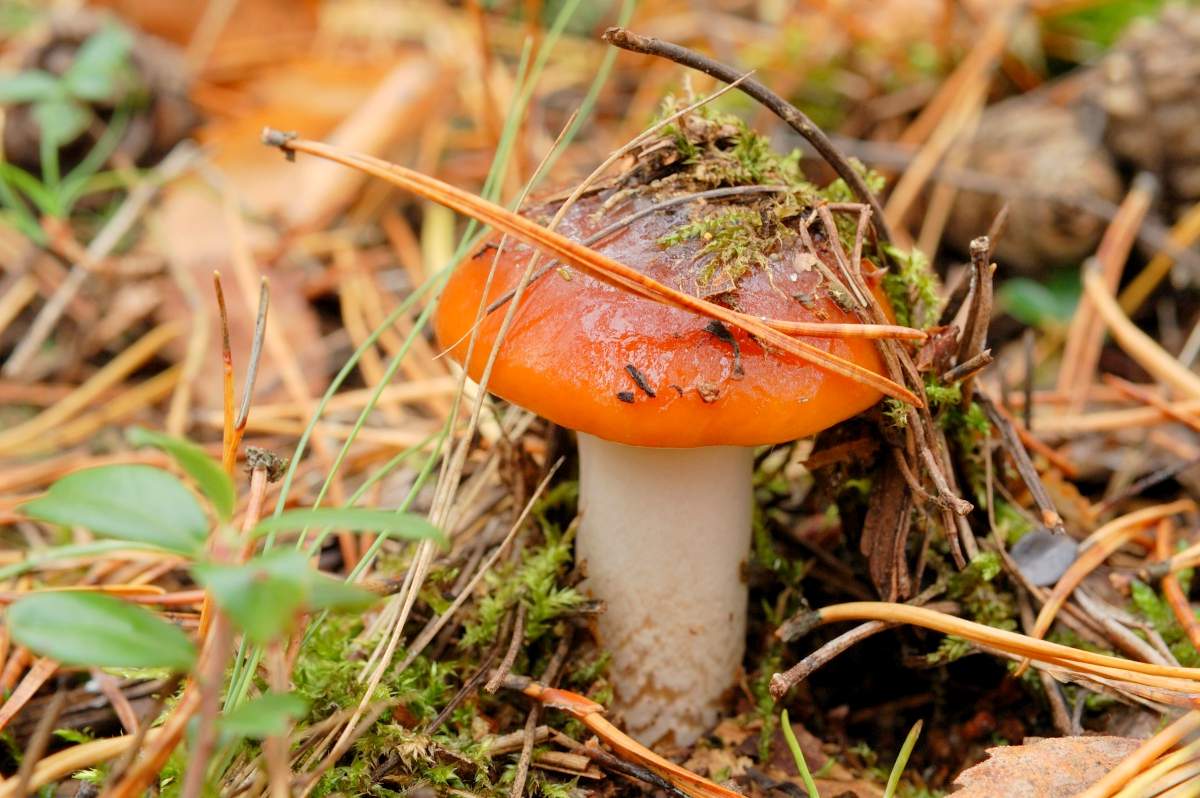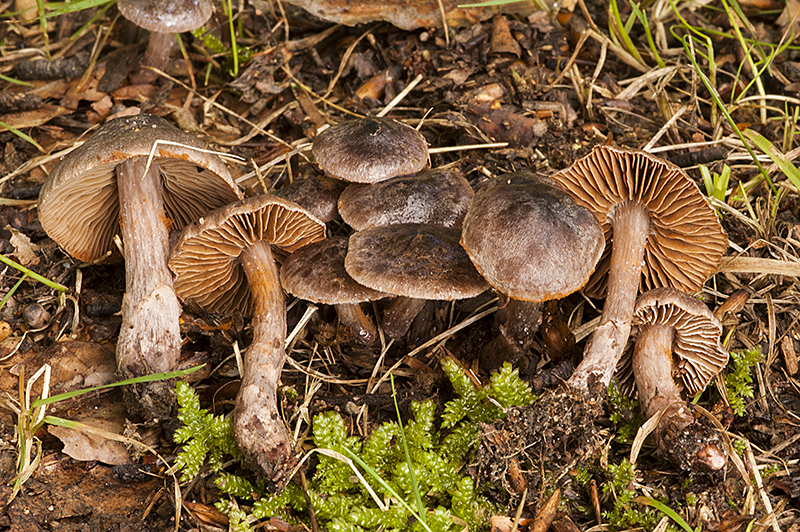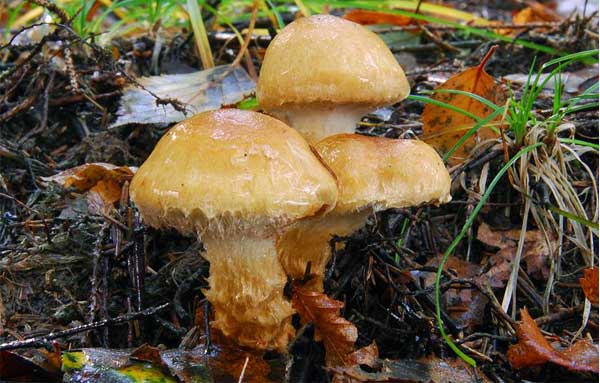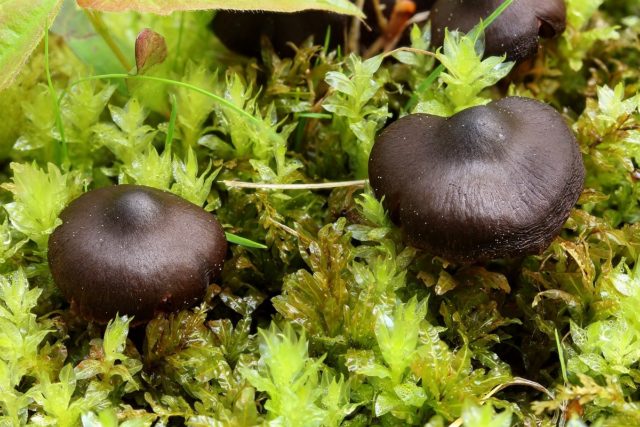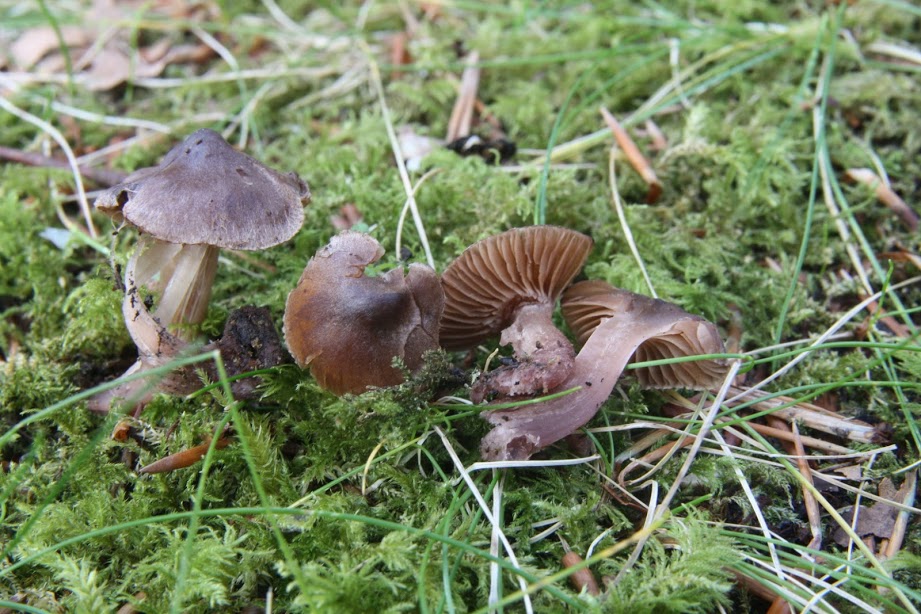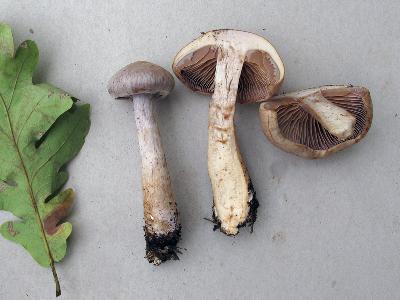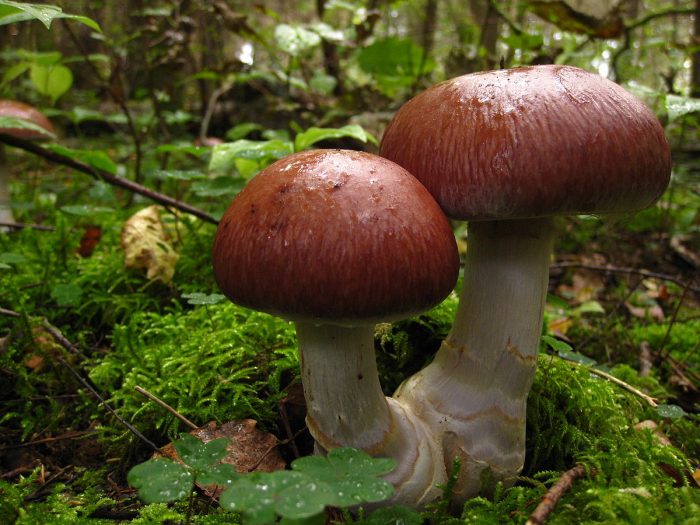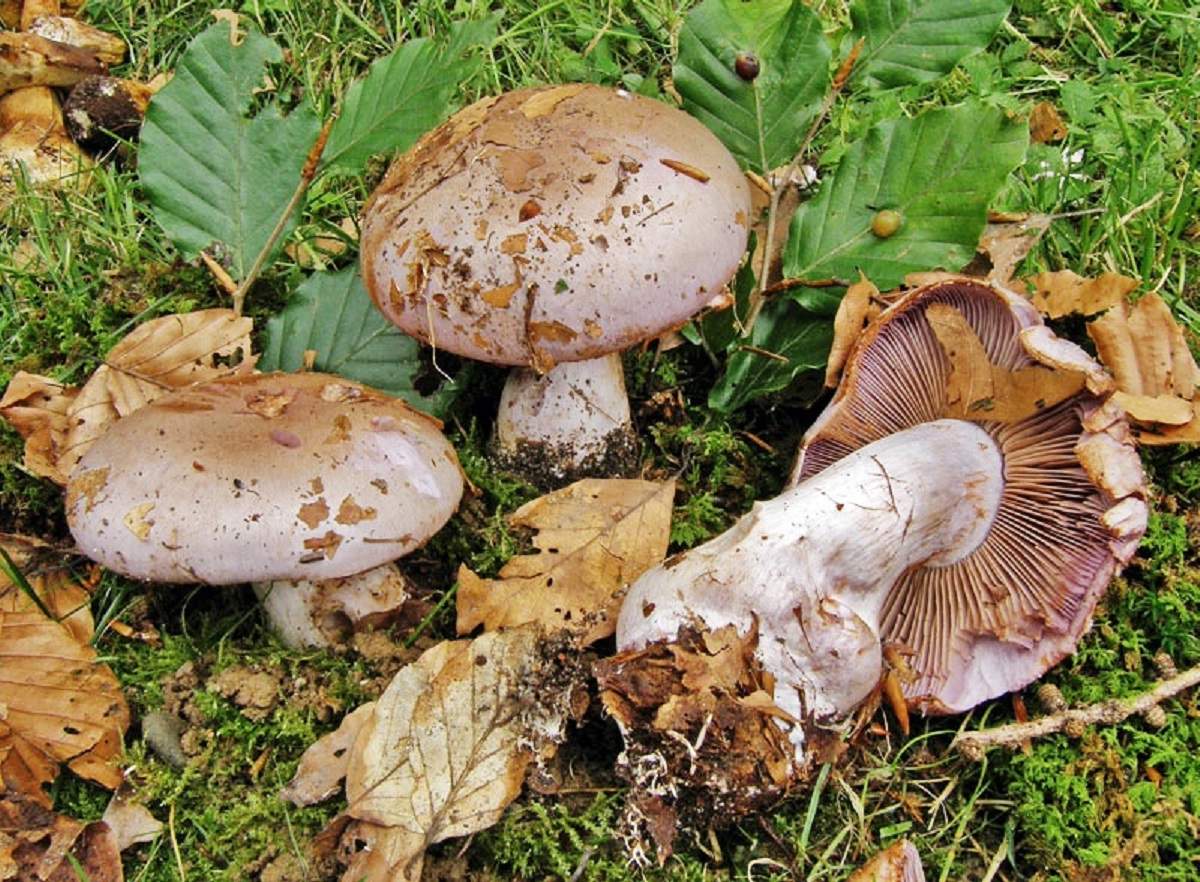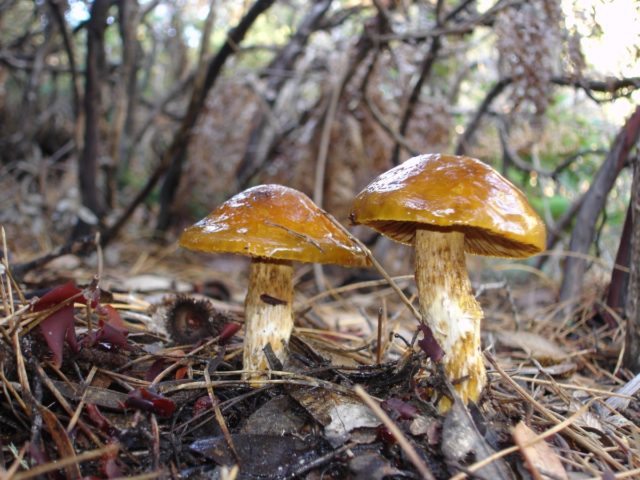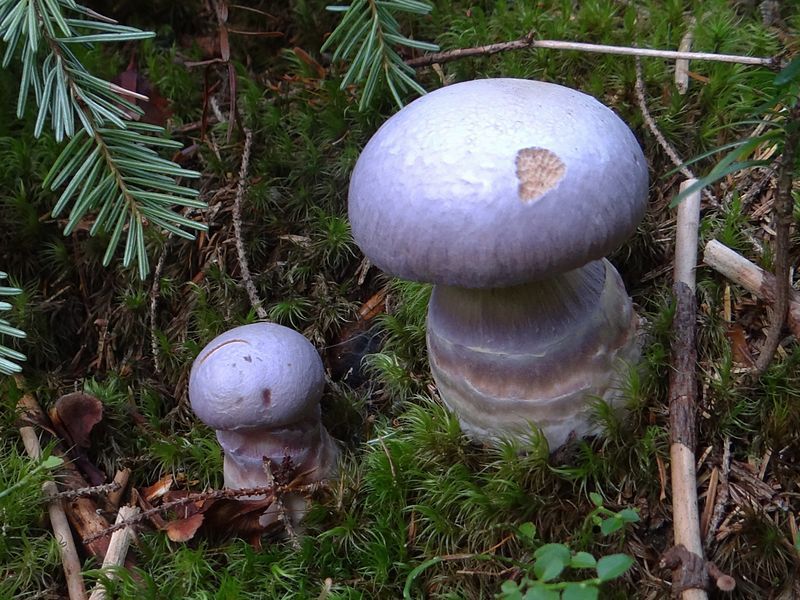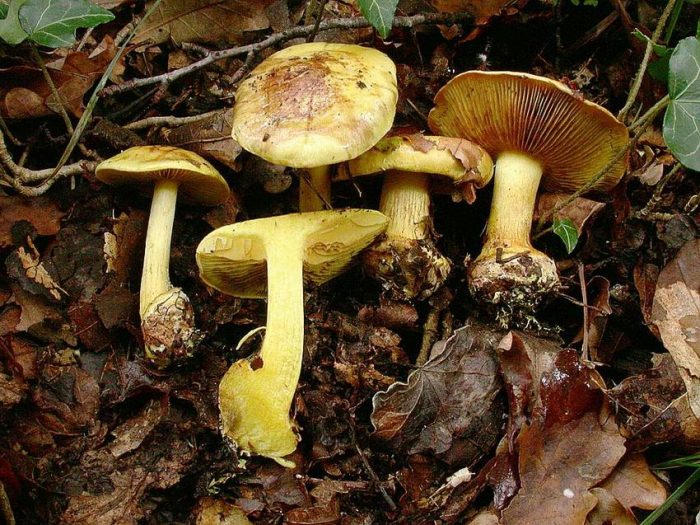Definitioner
- Basidia (Basidia)
-
Lat. Basidia. A specialized structure of sexual reproduction in fungi, inherent only in Basidiomycetes. Basidia are terminal (end) elements of hyphae of various shapes and sizes, on which spores develop exogenously (outside).
Basidia are diverse in structure and method of attachment to hyphae.
According to the position relative to the axis of the hypha, to which they are attached, three types of basidia are distinguished:
Apical basidia are formed from the terminal cell of the hypha and are located parallel to its axis.
Pleurobasidia are formed from lateral processes and are located perpendicular to the axis of the hypha, which continues to grow and can form new processes with basidia.
Subasidia are formed from a lateral process, turned perpendicular to the axis of the hypha, which, after the formation of one basidium, stops its growth.
Based on morphology:
Holobasidia - unicellular basidia, not divided by septa (see Fig. A, D.).
Phragmobasidia are divided by transverse or vertical septa, usually into four cells (see Fig. B, C).
By type of development:
Heterobasidia consists of two parts - hypobasidia and epibasidia developing from it, with or without partitions (see Fig. C, B) (see Fig. D).
Homobasidia is not divided into hypo- and epibasidia and in all cases is considered holobasidia (Fig. A).
Basidia is the place of karyogamy, meiosis and the formation of basidiospores. Homobasidia, as a rule, is not functionally divided, and meiosis follows karyogamy in it. However, basidia can be divided into probasidia - the site of karyogamy and metabasidia - the site of meiosis. Probasidium is often a dormant spore, for example in rust fungi. In such cases, probazidia grows with metabasidia, in which meiosis occurs and on which basidiospores are formed (see Fig. E).

See Karyogamy, Meiosis, Gifa.
- Pileipellis
-
Lat. Pileipellis, skin - differentiated surface layer of the cap of agaricoid basidiomycetes. The structure of the skin in most cases differs from the inner flesh of the cap and may have a different structure. The structural features of pileipellis are often used as diagnostic features in descriptions of fungi species.
According to their structure, they are divided into four main types: cutis, trichoderma, hymeniderma and epithelium.
See Agaricoid fungi, Basidiomycete, Cutis, Trichoderma, Gimeniderm, Epithelium.
- Ixokutis
-
Cutis, consisting of hyphae immersed in mucus. The surface of the cap is oily, slippery or slimy.
Lat. Ixocutis.
See Cutis, Gifa.
Blood-reddish webcap (Cortinarius semisanguineus)
Other names:
Red-lamellar or blood-reddish webcap (lat.Cortinarius semisanguineus) is a species of mushrooms belonging to the genus Cortinarius of the Cortinariaceae family.
Red-plate spiderweb cap:
Bell-shaped in young mushrooms, with age it very quickly acquires a "half-open" shape (3-7 cm in diameter) with a characteristic central tubercle, in which it stays until very old age, sometimes only cracking at the edges. The color is rather changeable, dim: brown-olive, red-brown. The surface is dry, leathery, velvety. The flesh of the cap is thin, firm, of the same indeterminate color as the cap, although it is lighter in color. Smell and taste are not pronounced.
Plates:
Quite frequent, adherent, with a characteristic blood-red color (which, however, smoothes out with age, as the spores mature).
Spore powder:
Rusty brown.
Red-plate leg:
4-8 cm high, lighter than the cap, especially in the lower part, often curved, hollow, covered with not very noticeable remnants of a spider web. The surface is velvety and dry.
Spreading:
The blood-reddish cobweb is found throughout the fall (often from mid-August to the end of September) in coniferous and mixed forests, forming mycorrhiza, most likely, with pine (according to other sources, with spruce).
Similar species:
There are more than enough similar cobwebs belonging to the subgenus Dermocybe ("skinheads"); a close spider web blood-red (Cortinarius sanguineus), distinguished by a red cap, like young plates.
Edible: It is not really known whether the mushroom is poisonous or simply inedible - apparently, there are no people willing to check it.
Remarks The blood-reddish webcap immediately attracts attention with its Russian name. Cortinarius semisanguineus can be translated in different ways, but probably the most awkward translation has become generally accepted.
However, words are words, and a cobweb is a cobweb. This species differs slightly from the beautiful, bright and rare blood-red webcap; it is precisely this beauty and brightness that is different. But under the unattractive gray-brown sign lurks all the same rage and pride as that of a red, not reddish, fellow. And from the blood-reddish cobwebs, dye for wool is obtained. If you can imagine sheep breeders wandering through the forest looking for special cobwebs for paint, imagine it yourself. It's hard for me.
Yellow webcap (Cortinarius triumphans)
- Other names for the mushroom:
- Triumphal webcap
- Pantaloons yellow
- Pantaloons triumphal
Synonyms:
- Triumphal webcap
- Pantaloons yellow
- Pantaloons triumphal
Yellow Webcap Hat:
Diameter 7-12 cm, in youth it is hemispherical, with age it becomes cushion-shaped, half-extended; noticeable scraps of cobweb cover often remain along the edges. Color - orange-yellow, in the central part, as a rule, darker; the surface is sticky, although it can dry out in very dry weather. The flesh of the cap is thick, soft, white-yellowish in color, with an almost pleasant smell, not typical for cobwebs.
Plates:
Weakly adherent, narrow, frequent, light cream in youth, change color with age, acquiring a smoky and then gray-brown color. In young specimens, they are completely covered with a light cobweb blanket.
Spore powder:
Rusty brown.
Leg:
The leg of a yellow spider web is 8-15 cm high, 1-3 cm thick, in youth it is strongly thickened in the lower part, with age it acquires a regular cylindrical shape. In young specimens, bracelet-like remains of the cortina are clearly visible.
Spreading:
The yellow webcap grows from mid-August to the end of September in deciduous forests, forming mycorrhiza mainly with birch. Prefers dry places; can be considered a companion of the black mushroom (Lactarius necator). The place and time of the most intensive fruiting of these two species often coincide.
Similar species:
The yellow webcap is one of the easiest cobwebs to define. Nevertheless, there are indeed a lot of similar species. The yellow webcap is classified only by a combination of characteristics - from the shape of the fruiting body to the time and place of growth.
Edibility:
The yellow webcap in foreign sources is classified as inedible mushrooms; Russian authors have a different opinion. SOUTH. Semenov in his book calls the yellow spider web the most delicious cobweb.
Remarks Black milk mushroom and yellow webcap are what stands in front of your eyes after several days of forest fermentation in mid-September. A lump in a basket, a cobweb in the forest. I'll have to try the other way around somehow. It is interesting to get acquainted with the yellow spider web from the culinary side, but of course, it is not possible to collect both abundant mushrooms at the same time. You have to choose.
Cooking recipes
Most lovers of quiet hunting, who managed to taste this forest fruit, believe that it does not show itself well in hot dishes, but in salted or marinade it is just what you need, moreover, the color turns out to be magical, fabulous. Cooking is fun and a little scary.It belongs to the 4th grade.
Primary processing
After the mushroom is delivered home, it should be well cleaned of forest debris, washed and removed from the top of the film. The purple panther is not soaked, since it does not have a bitter taste or milky juice, it is easy to prepare it.
Cooking
Salt water and boil mushrooms in it for an hour. After that, you can proceed to further actions. At the end of cooking, the broth is drained. Many mushroom pickers recommend removing the liquid and pouring a new one in the process. Both times the water will turn out to be very purple in color.
Pickling
A short and quick recipe for cooking. For pickling, you will need for 1 kg of fruits:
- salt - 2 tbsp. l .;
- sugar - 2 tbsp. l .;
- vinegar - 2 tbsp. l .;
- allspice peas - 5 pcs.;
- laurel leaf - 1 pc.;
- garlic - 5 cloves.
If you wish, you can use your own ingredients or remove the garlic (who does not like it), the main components are salt, sugar and vinegar. All these seasonings and spices are added to 2 liters of water and put on the fire, after boiling it is necessary to immerse the prepared and boiled mushrooms there, then keep on the fire for another 20 minutes.
Then put the fruits in jars and add the marinade to the top. Sterilize for 15 minutes. Roll up the lids and let cool. Store in a cool, dark place after refrigeration.
Salting
After completing the 40-minute boiling, remove the mushrooms from the water, lay them in layers in a prepared container, sprinkle them with salt. In this case, if desired, you can add finely chopped garlic, dill, currant or horseradish leaves, laurel, peppercorns or other seasonings.
Cover with a clean cloth and press down with pressure. A day later, juice will be released, in which the webcap will continue to be salted. You can try it after 40 days, and during this period, regularly check the covering material, rinse or change to a new one if necessary.
At the end of the salting, put the product in jars, pour brine to the top and put in a cool place or in the refrigerator.
Symptoms of poisoning with poisonous species of these mushrooms can appear 2 weeks after eating them.
In small purple pimples, a cobweb is observed, which is why they began to be called that. It closes the hymenophore, breaks with age and disappears.
By creating mycorrhiza with trees, the fungus exchanges useful substances with them, they mutually help each other in growth and development.
The purple webcap is not the most common mushroom, it is undesirable to collect it, but you can even admire it. The unusual color gives the feeling of a fairy tale, and the surrounding space is shrouded in the mysterious beauty of nature. Its taste does not cause much delight, and the color often frightens mushroom pickers with its brightness and toxicity, it is very unusual.
Webcap characteristics
Hat
- Advertising -
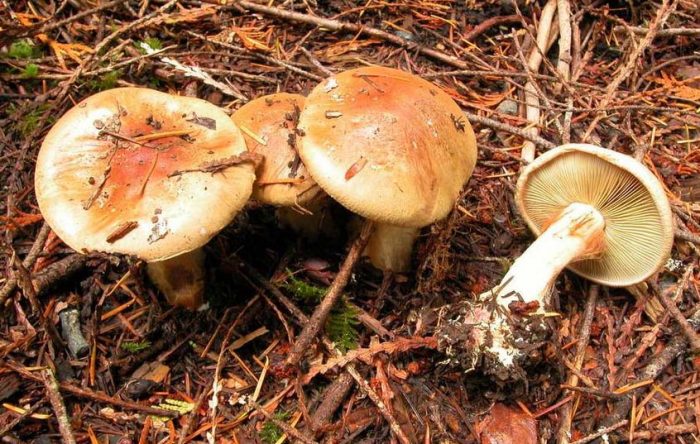
The cap is hemispherical or conical, also convex or flat, with a pronounced tubercle, the surface is dry or mucous, smooth, fibrous, occasionally scaly. The color is different, from yellow to ocher, orange, brown, dark red, brown or purple, fades with age.
Pulp
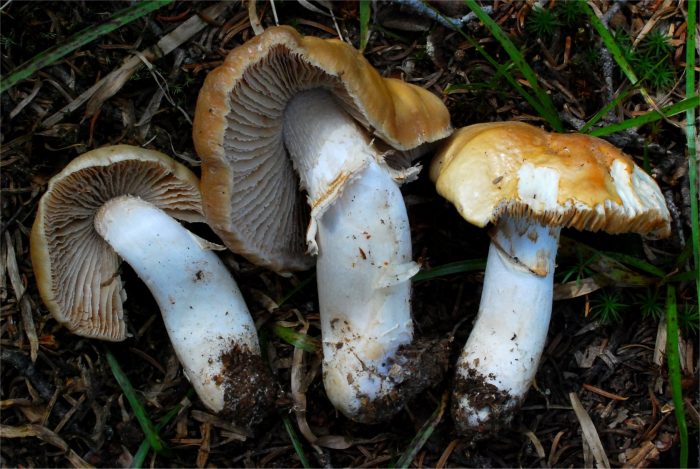
In the cap, the flesh is fleshy or thin, white or ocher, brown or yellow, less often blue, purple or green. On the cut, the color changes.
Leg
- Advertising -
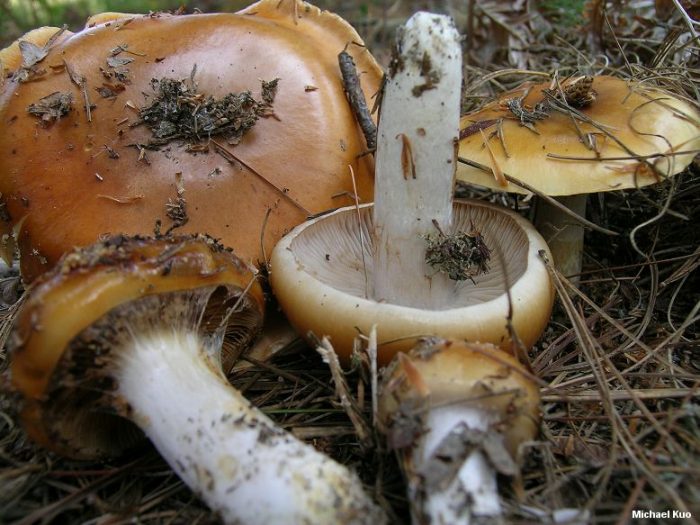
The stem is cylindrical or clavate, with a thickening at the base, the color is the same as the cap, the surface is dry or slimy, fibrous.
Lazy webcap (Cortinarius bolaris)
Lazy webcap (lat.Cortinarius bolaris) is a poisonous mushroom of the Spiderweb family (Cortinariaceae).
Hat:
Relatively small (3-7 cm in diameter), pokular-like in youth, gradually opens to slightly convex, cushion-shaped; in older mushrooms, it can be completely spread, especially in dry times. The surface of the cap is densely covered with characteristic red, orange or rusty-brown scales, which makes the mushroom easily recognizable and visible from a distance. The flesh of the cap is white-yellowish, dense, with a faint musty odor.
Plates:
Wide, adherent, medium frequency; in youth, gray, with age, like most cobwebs, become rusty brown from maturing spores.
Spore powder:
Rusty brown.
Leg:
Usually short and thick (3-6 cm in height, 1-1.5 cm in thickness), often twisted and twisted, dense, strong; the surface, like that of the cap, is covered with scales of the corresponding color, albeit not so evenly. The pulp in the leg is fibrous, dark at the base.
Spreading:
Lazy webcap meets in September-October in forests of various types, forming mycorrhiza, apparently, with trees of different species, from birch to pine. Prefers acidic soils, bears fruit in damp places, in mosses, often in groups of fungi of different ages.
Similar species:
Cortinarius bolaris in its typical form is difficult to confuse with any other cobweb - the variegated color of the cap practically eliminates error. Literature, however, points to a certain cobweb of peacocks (Cortinarius pavonius), a mushroom with purple plates in youth, but whether it grows with us is still a big question.
Edible: The mushroom is inedible or weakly (if not weakly) poisonous.
Remarks The fact that Cortinarius bolaris is classified as a "small webcap" is a big deception! Knowing about the colorful "bumpkin", I searched for it for a long time among small variegated mushrooms, I searched and did not find it; he, however, was not there, for when this mushroom is, doubts disappear by themselves. Beautiful crimson-and-motley hats in green moss, like the eggs of an alien invader - what a find could be more beautiful! And I would sharply criticize people who pluck and scatter lazy cobwebs around the neighborhood. Cortinarius bolaris bears no resemblance to any fungus that may be of interest to the purveyor. With none. So why should he tolerate from people what he would not tolerate? I do not understand this and do not want to understand.
Description of the mushroom
Pribolotnik purple or lilac cobweb - these are the names that can be heard among amateurs and scientists. Latin names and synonyms: Cortinarius violaceus, Agaricus violaceus and Gomphos violaceus. The mushroom belongs to the Spiderweb genus of the Spiderweb family.
The cap grows on average up to 10 cm in diameter, the largest specimens are 15 cm. Convex, cushion-shaped as it grows, it becomes prostrate in old ones. With age, the edge also becomes wavy. The surface is purple, felt with scales.
The hymenophore (bottom of the cap) consists of plates, pronged to the stem. They are sparsely located, rather wide, purple. Spores are brownish, slightly rusty.
The flesh in the section does not change, has a purple or bluish color, often grayish. There is no smell, sometimes there is a nutty flavor.
The leg can reach 12 cm in height, and its thickness is no more than 2 cm. The top is covered with scales, expands downward in the form of a tuber. The color is purple, brownish, fibrous pulp.
The mushroom is listed in the Red Book of Russia. It is found in the European part and the Far East, in Siberia, Tomsk and Chelyabinsk regions, Krasnoyarsk Territory. It is considered a rare species, not fully understood.
A bit of history
The first to describe the purple spiderweb mushroom was the British explorer Samuel Frederick Gray. He was engaged not only in the study of botany, but also in pharmacology and chemistry.
Scaly webcap: photo and description
| Name: | Scaly webcap |
| Latin name: | Cortinarius pholideus |
| Type of: | Conditionally edible |
| Specifications: |
|
| Systematics: |
|
Scaly webcap is a conditionally edible representative of the Webinnikov family. But due to the lack of taste and a weak musty aroma, it has no nutritional value.It grows among spruce and deciduous trees, in a humid place. Occurs singly or in small groups from August to October.
Description of the scaly spider web
Since the mushroom belongs to the 4th group of edibility, it is important to be able to distinguish it and to know the time and place of growth. Therefore, acquaintance with the scaly cobweb must begin with external characteristics.

The fungus grows in humid places
Description of the hat
The bell-cap, as it ripens, straightens and becomes flat-convex. The surface is covered with light brown or rusty brown skin with dark coffee scales. The edges are light, sometimes they take on an olive tint.
The spore layer consists of rare, partially adherent plates, which are covered with a thin web at the initial stage of development. At the beginning, they are colored in a light chocolate color with a purple tint, as they grow, they become rusty-brown. Reproduction occurs with microscopic spores, which are in a whitish powder.
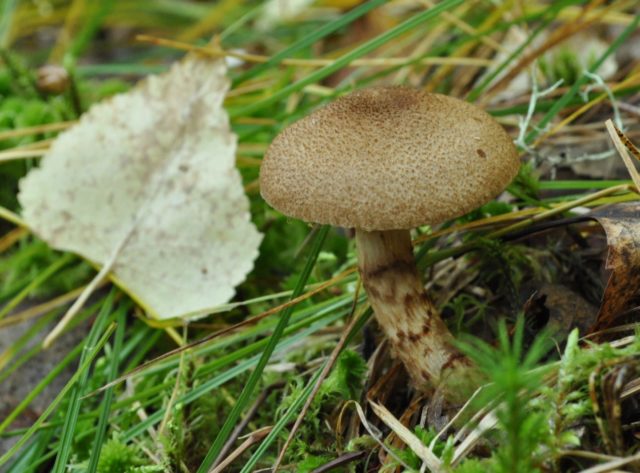
In cooking, only caps of young mushrooms are used.
Leg description
The small, slender stem is club-shaped. The surface is smooth, light brown in color. Closer to the ground, the leg thickens, and the color changes to dark rusty. The pulp is loose, light purple in color, tasteless, with an unpleasant musty odor.

The fleshy leg has an unpleasant odor
Where and how it grows
This representative prefers to grow in a humid place, near water bodies, on wet moss, among spruce and deciduous trees. Grows in small families, bears fruit from August to October.
Is the mushroom edible or not
Scaly webcap after prolonged heat treatment is used in cooking. Fried, stewed and canned dishes can be prepared from the harvested crop. Only the caps of young specimens are used for food. Mushroom picking should be carried out in dry, sunny weather, in ecologically clean places.
Doubles and their differences
Scaly webcap, like all inhabitants of the forest, has similar twins. These include:
- Red olive - a conditionally edible representative of the mushroom kingdom. You can recognize the species by a spherical or open hat of lilac-purple color. The leg is fleshy, slightly purple in color. The pulp is dense, the taste is bitter. A rare fungus, it settles in mixed forests in small groups. Fruiting during the entire warm period.
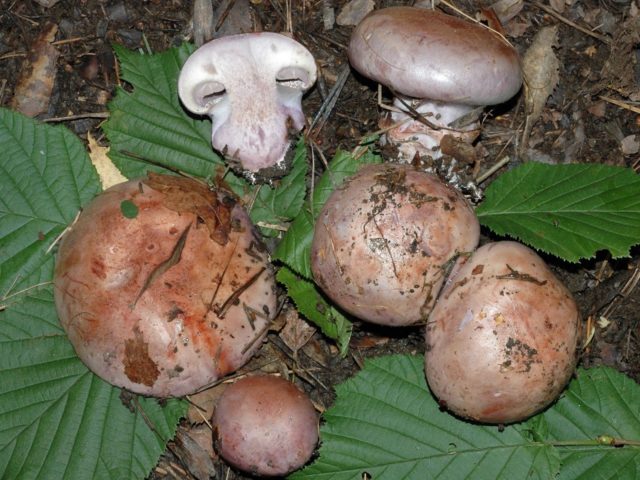
Grows in mixed forests
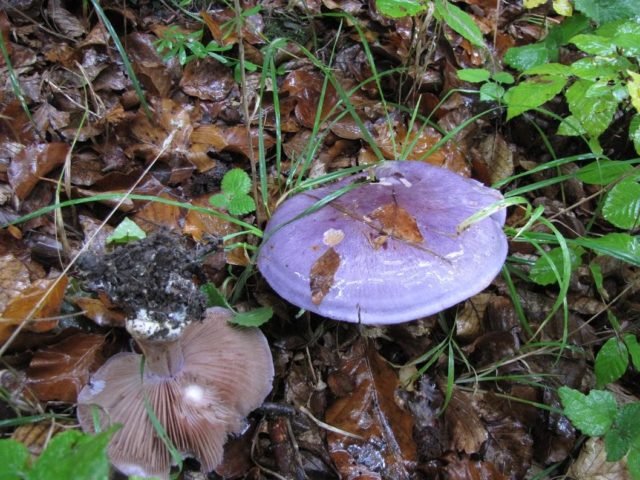
Fruiting from August to October
Conclusion
Scaly webcap is a conditionally edible mushroom. It grows in mixed forests, the caps of young species are used in cooking
To recognize a mushroom, it is important to know a detailed description, view photo and video materials
Evaluation of taste, medicinal properties, benefits and possible harm
The lilac cobweb does not have the highest taste, and Insert shortcode can be boiled and fried, as well as salted and pickled. Collecting the mushroom is not recommended, since it is rare and it will not be possible to collect a large amount, it grows mostly singly, it does not appear every year.
Like most mushrooms, purple spiderweb contains B vitamins, zinc, copper, and manganese, the smell of which many people smell when cut. There is information that it is used in pharmacology for the manufacture of antifungal agents and antibiotics. Helps lower glucose levels, has anti-inflammatory properties, and supports the immune system.
How to distinguish from edible counterparts
Experienced mushroom pickers do not often confuse the common cobweb with other members of the genus, but sometimes it may look like a slime cobweb (lat.Cortinarius mucifluus), which is considered conditionally edible
However, it is important not to confuse it with the inedible slimy spider web (Cortinarius mucosus)
Slime webcap
The above fruiting bodies are distinguished by a longer stem and a thicker mucus layer. The color of the hymenophore is cream.
Difference from the Triumphal Webcap
Triumphant Webcap
Sometimes it can be mistaken for the Triumphal Webcap (Cortinarius triumphans), popularly called the golden or yellow spiderweb. However, upon closer inspection, you will notice the following differences:
- the diameter of the cap is 5-12 cm;
- mucus becomes fibrous when it dries;
- the color in the center of the cap is brighter, and closer to the edge it becomes paler;
- the plates of the hymenophore with a notch grow to the stem, in immature mushrooms they have a bluish-cream shade, and later acquire a brown color with light edges;
- belts of scales are visible on the leg;
- pulp without much pronounced taste and smell.
In addition, Cortinarius triumphans is considered the most widespread and collected member of the genus.
The considered type of fruiting body is inedible and is not eaten. However, until now, its nutritional qualities have not been fully studied. According to some reports, the fungus poses a particular danger to the human body, since the slow-acting toxins included in its composition can gradually harm the digestive system. Symptoms of poisoning with this fruiting body can only appear after 1-2 weeks of eating it, which significantly reduces the chance of successful treatment.
Meanwhile, some experts argue that the spider web is free of toxins, but unfit for food only because of its unpleasant odor and lackluster taste.
In order for the mushroom picking season to pass safely, it is worth carefully studying the description of the common webcap, to find out how it is similar to edible representatives of its kind. Then you can safely eat delicious dishes and avoid poisoning.
External description
Light buffy webcap (Cortinarius claricolor) is a mushroom with a dense and strong fruiting body. The color of the cap is light ocher or brownish. In young specimens, the edges of the cap are bent downward. Then they open, and the hat itself is made flat.
The hymenophore is lamellar, and the plates of young fruiting bodies are covered with a veil of a light shade, very similar to a cobweb (for this the mushroom got its name). When the mushrooms are ripe, the veil disappears, leaving a white mark around the edges of the cap. The plates themselves, after the coverlet is dropped, have a white color, over time they become dark, similar in color to clay.
The leg of ocher cobwebs is thick, fleshy, and long. In color, it is light, light ocher, in some specimens it is widened at the bottom. On its surface, you can see the remains of the bedspread. The inside is full, dense and very juicy.
The mushroom flesh of the spiderweb is light ocher, often white, and can have a bluish-lilac cast. Dense, juicy and tender. An interesting fact is that light buffy cobwebs are rarely attacked by insect larvae.

